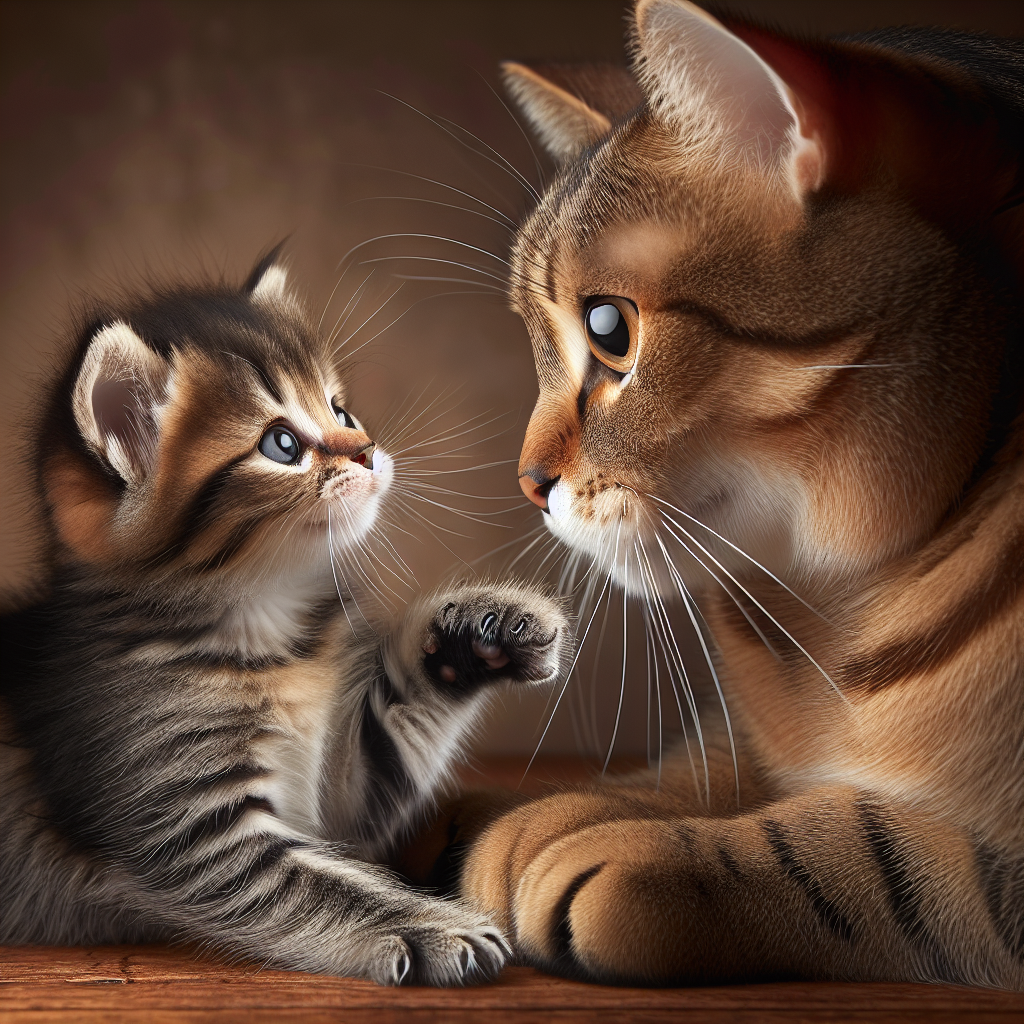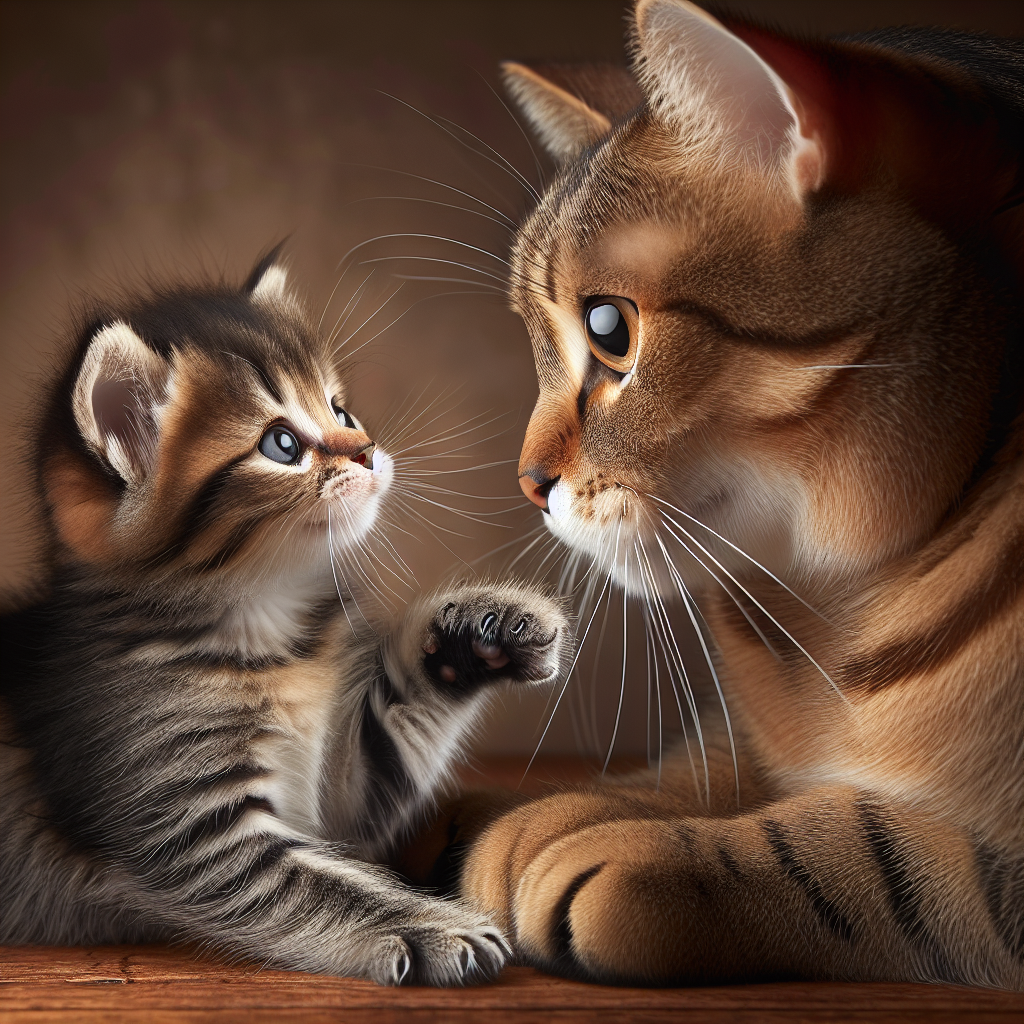Imagine bringing home a new set of adorable kittens, only to find that your resident tabby cat is less than thrilled about their arrival. Helping your kittens bond with your tabby cat can be a rewarding and heartwarming experience for everyone involved. With a few simple tips and tricks, you can create a harmonious environment where they can all coexist peacefully, forming an undeniable bond that will melt your heart. In this article, we will explore various strategies to help your kittens and tabby cat form a strong and loving bond, ensuring a happy and united feline family.
Preparing for Introduction
Understanding the importance of a gradual introduction
When bringing a new kitten into a household that already has a resident tabby cat, it’s crucial to understand the significance of a gradual introduction. Cats are territorial animals, and sudden introductions can lead to stress, anxiety, and even aggression. By taking the time to introduce them slowly, you can help them build a positive relationship and foster a harmonious environment.
Creating a safe and comfortable environment
Before bringing the new kitten home, it’s important to create a safe and comfortable environment for both cats. This means providing separate spaces for them to retreat to when needed, such as individual sleeping areas and designated feeding stations. Each cat should have their own litter box, as well as vertical spaces like cat trees or shelves to establish their territories and allow for a sense of ownership.
Gathering necessary supplies
When preparing for the introduction, make sure you have all the necessary supplies on hand. This includes separate food and water bowls, litter boxes, toys, bedding, and blankets. Having these items readily available will help facilitate a smooth transition and ensure that each cat feels comfortable and secure in their own space.
Establishing feeding and litter routines
Establishing consistent feeding and litter routines is essential for both cats. Cats thrive on routine, and having set feeding times will not only help with their digestion but also create a positive association around mealtime. Similarly, providing each cat with their own litter box will prevent conflicts and promote a sense of ownership. Be sure to keep their litter boxes clean to encourage regular use and prevent any potential issues.
Setting up Separate Spaces
Providing individual sleeping areas
Cats value their personal space and having designated sleeping areas is vital in promoting a peaceful coexistence. Each cat should have their own cozy bed or separate sleeping spots in different parts of the house. This allows them to retreat to a quiet and comfortable space whenever they desire some alone time or a peaceful slumber.
Setting up separate feeding stations
Just as each cat needs their own sleeping area, they should also have separate feeding stations. This helps to prevent any potential conflicts or competition during mealtimes. By providing each cat with their own bowl and designated feeding area, you can ensure that they feel secure and have a positive association with their food.
Allocating separate litter boxes
Having multiple litter boxes is crucial when introducing a new kitten to a tabby cat. Each cat should have their own litter box, ideally placed in different areas of the house to avoid territorial disputes. Cats are extremely particular about their litter box hygiene, and providing individual boxes will prevent any stress or anxiety related to sharing this essential space.
Creating vertical spaces for each cat
Vertical spaces such as cat trees, shelves, or window perches are essential for both cats as they establish their territories and seek comfort in elevated positions. Cats inherently prefer to survey their surroundings from an elevated vantage point, giving them a sense of security. Providing vertical spaces for each cat allows them to have their own area and reduces the chances of conflicts arising from territorial disputes.

Scent Swapping
Understanding the significance of scent
Scent plays a crucial role in a cat’s perception of their environment and other feline companions. Cats rely heavily on scent to communicate, mark their territory, and establish familiarity. By understanding the significance of scent, you can use it as a tool to help your kittens bond with your tabby cat.
Exchanging bedding and blankets
Exchange bedding and blankets between the cats to introduce their scents gradually. Place the kitten’s bedding and blankets in the tabby cat’s territory and vice versa. This method allows them to become familiar with each other’s scent in a non-threatening way, easing the transition and fostering a sense of comfort and familiarity.
Using a cloth to transfer scents
Take a clean cloth and gently rub it on one cat’s face, then transfer the scent to the other cat by rubbing it on their face. This scent transfer mimics the bonding that occurs when cats groom each other. It helps to associate their scents with positive experiences and aids in building trust and familiarity.
Introducing the scents to respective areas
Introduce the scents of both cats into their respective areas. For example, place a towel rubbed against the tabby cat’s cheek near the kitten’s sleeping area. Similarly, place a towel with the kitten’s scent near the tabby cat’s resting spot. This cross-exposure of scents helps them get accustomed to each other’s presence and fosters a sense of shared territory.
Visual Introduction
Using a barrier for initial face-to-face interaction
Before allowing the cats to have direct contact, it’s important to use a barrier to separate them physically. This can be a baby gate or a screen door that allows them to see and observe each other without the risk of physical contact. This initial visual introduction helps them become familiar with each other’s presence and body language without feeling threatened.
Allowing cats to observe each other
Through the use of the barrier, allow the cats to spend time observing each other. This gives them an opportunity to gauge each other’s behavior, body language, and reactions. Encourage positive behaviors by offering treats and praise, reinforcing the idea that being in each other’s presence is a good thing.
Positive reinforcement during visual encounters
During the visual encounters, use positive reinforcement techniques to reward desired behavior. This can include treats, praise, or gentle strokes. By associating positive experiences with the presence of the other cat, you are reinforcing the idea that being together is rewarding and pleasant.

Gradual Face-to-Face Meetings
Supervised visits in a controlled environment
Once the cats have shown positive reactions during the visual introduction, it’s time to progress to supervised face-to-face meetings in a controlled environment. Keep the initial meetings short and monitor their interactions closely. Choose a neutral space where neither cat feels overly territorial, and ensure that there are escape routes for both cats if needed.
Overcoming initial hissing or aggression
It’s not uncommon for cats to display initial hissing, growling, or even aggression during their first face-to-face meetings. This should not discourage you. Instead, stay calm and redirect their attention to positive experiences. Distract them with play or treats, and continue to reinforce positive behavior.
Creating positive associations through play
Engage the cats in interactive play sessions during their face-to-face meetings. Playing with interactive toys together can help them associate positive experiences and fun with each other’s presence. It allows them to bond over a shared activity and reduces tension or negative associations they may have previously had.
Gradually increasing the duration of meetings
As the cats become more comfortable with each other, gradually increase the duration of their face-to-face meetings. Monitor their interactions closely and provide them with a safe and positive environment during these sessions. Be patient and allow them to develop their own pace of bonding, ensuring that neither cat becomes overwhelmed or stressed.
Promoting Positive Associations
Feeding both cats together
Feeding both cats together can help promote positive associations and reduce any potential competition or jealousy. Start by placing their food bowls on opposite sides of the same room, gradually moving them closer together over time. This shared experience of enjoying a meal together can reinforce a sense of togetherness and diminish any negative feelings between them.
Engaging in interactive play sessions
Incorporate interactive play sessions involving both cats to help further their bond. Use toys that encourage them to engage with each other, such as teaser wands or feather toys. This shared playtime not only promotes physical activity but also allows them to build trust and companionship through the joy of play.
Using treats and rewards to encourage positive behavior
Rewarding positive behavior with treats and praise is a powerful tool in fostering a positive relationship between your kittens and tabby cat. Whenever they display friendly or tolerant behavior towards each other, offer treats as a reward. This positive reinforcement helps them learn that being together leads to pleasant experiences and strengthens their bond.
Providing individual attention and affection
While it’s important to promote bonding between the cats, it’s equally vital to provide individual attention and affection to each cat. Ensure that both kittens and the tabby cat receive individual playtime, lap snuggles, and grooming sessions. This shows them that their individual needs are still valued and prevents any potential jealousy or feelings of neglect.
Establishing a Routine
Maintaining consistent feeding schedules
Consistency is key when it comes to feeding schedules. Establish a routine where both cats are fed at the same time, preferably in their separate feeding stations. This routine provides a sense of security and familiarity, reducing any potential stress or competition during mealtimes.
Allocating playtime for bonding
Set aside dedicated playtime where you engage with both kittens and the tabby cat simultaneously. This playtime allows them to interact with each other and build their bond in a positive and fun environment. Incorporate interactive toys, laser pointers, or even simple string games to keep all cats engaged and entertained.
Keeping a structured sleep routine
Cats, including kittens and tabby cats, thrive on routine and structure. Establish a structured sleep routine by ensuring they have separate and comfortable sleeping areas. Encourage them to follow the routine by providing cozy beds, blankets, or even designated spots on furniture where they feel safe and secure during their rest.
Regular grooming sessions for both cats
Grooming is not only essential for your cats’ physical well-being but also a valuable bonding opportunity. Schedule regular grooming sessions where you can brush their fur, clean their ears, and trim their nails. This shared experience creates a positive association between you as the caregiver and will further strengthen the bond between the kitties and the tabby cat.
Addressing Behavioral Challenges
Identifying signs of stress or anxiety
While introducing kittens to a tabby cat, it’s crucial to be aware of signs of stress or anxiety in all three cats. Look for indications such as excessive hiding, aggression, changes in appetite, or litter box issues. Identifying these signs early allows you to address any concerns and implement stress-reducing techniques.
Implementing stress-reducing techniques
If any of the cats are displaying signs of stress or anxiety, make adjustments to the introduction process. Provide more separate spaces, increase the length of visual or face-to-face meetings gradually, and ensure ample positive reinforcement. Additionally, utilize calming pheromone diffusers or sprays designed specifically for cats to create a more relaxed environment.
Seeking professional assistance if necessary
In some cases, despite your best efforts, the cats may struggle to bond or display continued aggression towards each other. If the behavioral challenges persist or worsen, it may be beneficial to seek professional assistance from a veterinarian or animal behaviorist. They can provide tailored advice and strategies to help overcome any specific issues and facilitate a healthy relationship between the cats.
Monitoring Progress
Observing their interactions
As the cats progress through the introduction process, closely observe their interactions whenever they are together. Look for signs of tolerance, curiosity, and positive body language. Note how they approach each other, whether they engage in play or grooming behaviors, and if they choose to spend time in close proximity. Regular monitoring allows you to gauge their progress and make any necessary adjustments.
Noticing positive body language
Positive body language is a good indicator of progress in their bond. Look for signs such as relaxed body postures, slow blinks, and friendly tail movements. Purring, rubbing against each other, and reciprocal grooming are all positive signs that they are comfortable and establishing a bond. Celebrate these moments and reinforce their positive behavior with treats and affection.
Assessing any remaining signs of tension
While progress is expected during the introduction process, it’s important to remain vigilant for any remaining signs of tension between the cats. Pay attention to any abrupt changes in behavior or recurring instances of aggression, as this may indicate a need to revisit certain aspects of the introduction process. Gradually adjust the interaction levels and seek professional advice if necessary.
Recognizing milestones in their bond
As the cats continue to grow and develop their bond, celebrate their milestones along the way. Each time you witness them engaging in positive interactions, sharing affection, or simply comfortable in each other’s presence, acknowledge and reward their progress. Recognizing these milestones reinforces their newfound friendship and encourages further bonding.
Being Patient and Persistent
Understanding that bonding takes time
Patience is key when it comes to helping kittens bond with a tabby cat. Just like human relationships, bonding between cats takes time and cannot be rushed. Respect each cat’s comfort level and allow them to set the pace. By understanding the gradual nature of the process, you can nurture a strong and lasting bond between your kittens and tabby cat.
Avoiding rushing the process
As tempting as it may be to speed up the bonding process, rushing can lead to setbacks and increased stress for the cats. Avoid pushing them into situations they are not ready for and allow them to become comfortable at their own pace. Trust the process and celebrate every step forward, no matter how small it may seem.
Consistently reinforcing positive behaviors
Consistency is crucial throughout the introduction process. Continuously reinforce positive behaviors with treats, praise, and affection. By consistently rewarding their desired actions, you are emphasizing the value of their positive interactions and establishing a foundation for a strong and loving bond.
Adapting strategies as necessary
Each cat is unique, and the introduction process may require adjustments based on their individual personalities and needs. Stay open and adaptable, being willing to modify your strategies as necessary. What works for one cat may not work for another, so be prepared to make changes and try different methods until you find what truly helps the kittens bond with your tabby cat.
Remember, with time, patience, and a gentle approach, your kittens and tabby cat can form a beautiful bond and become lifelong companions.

